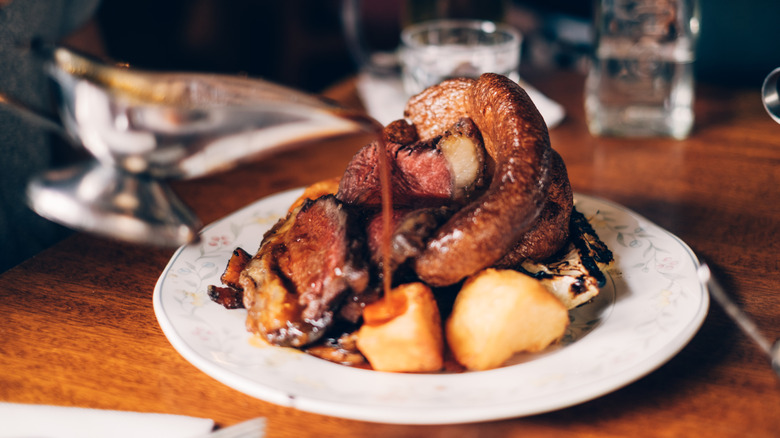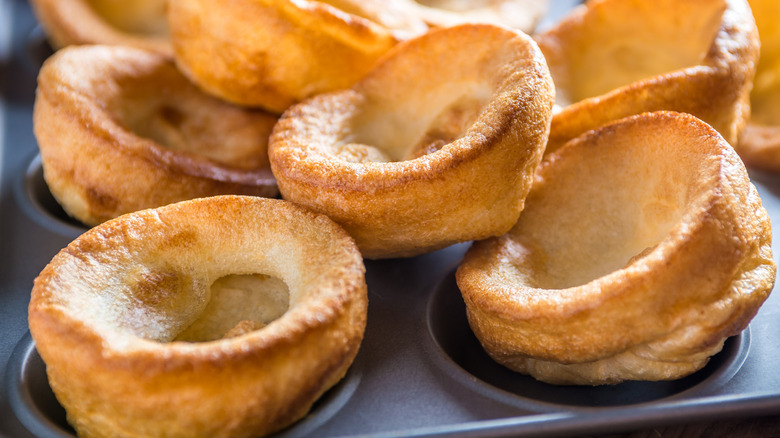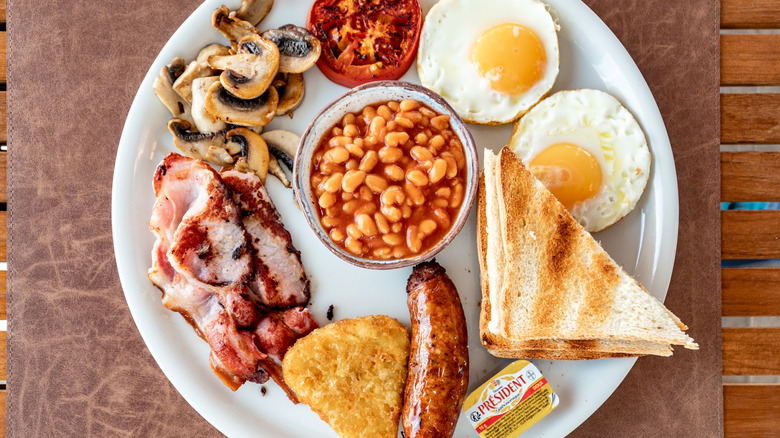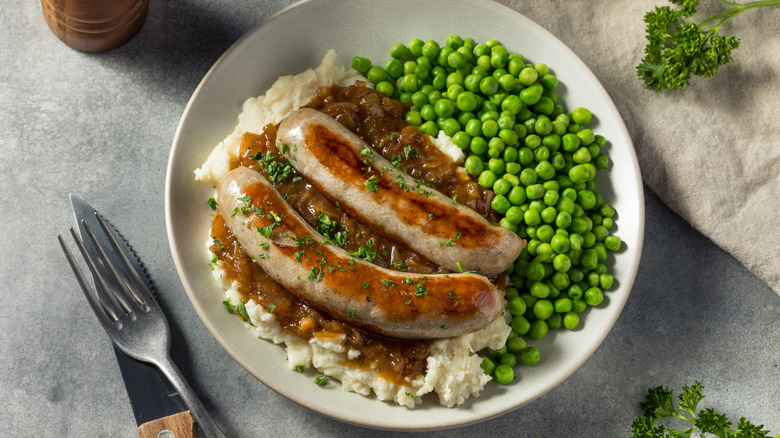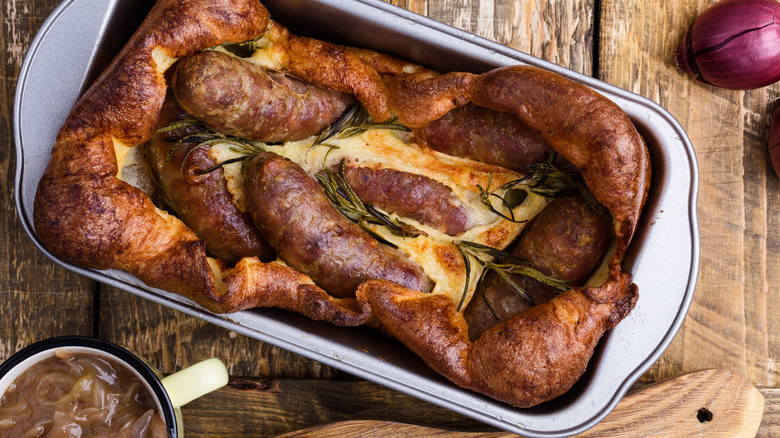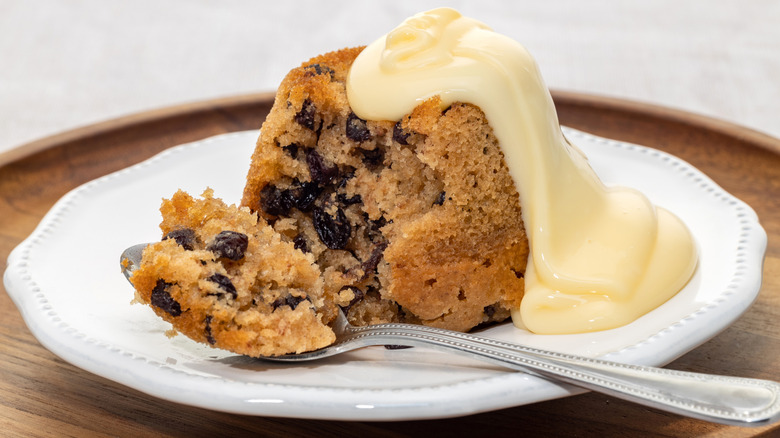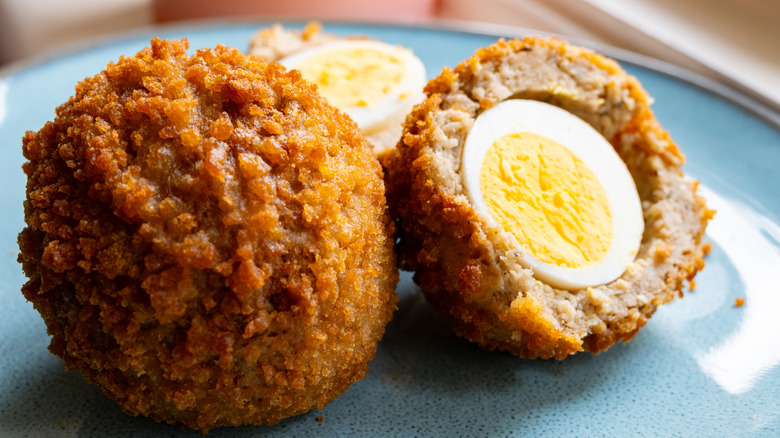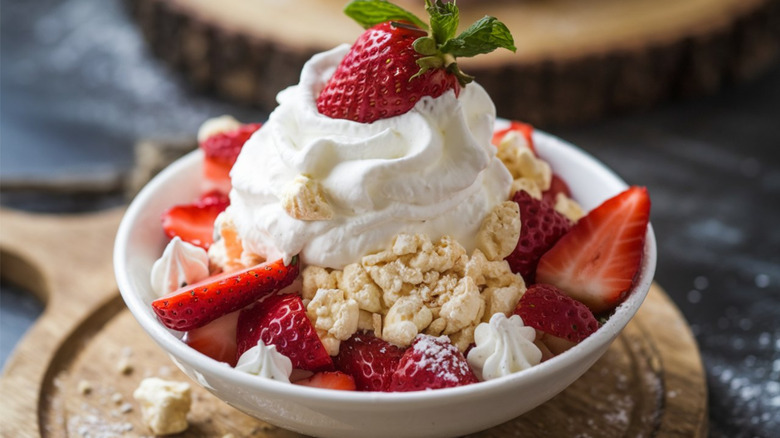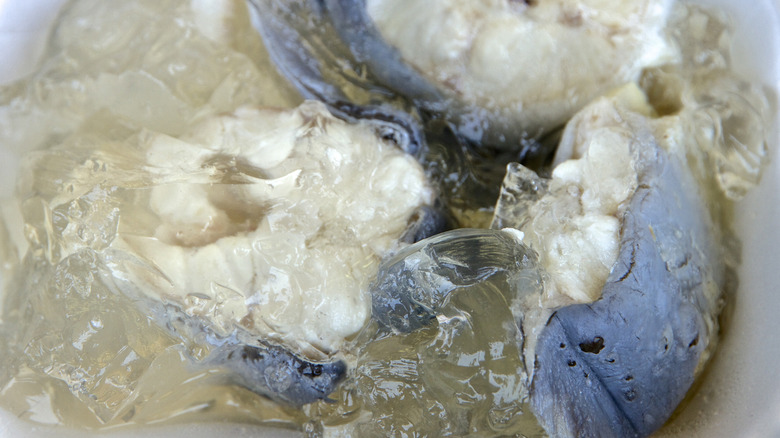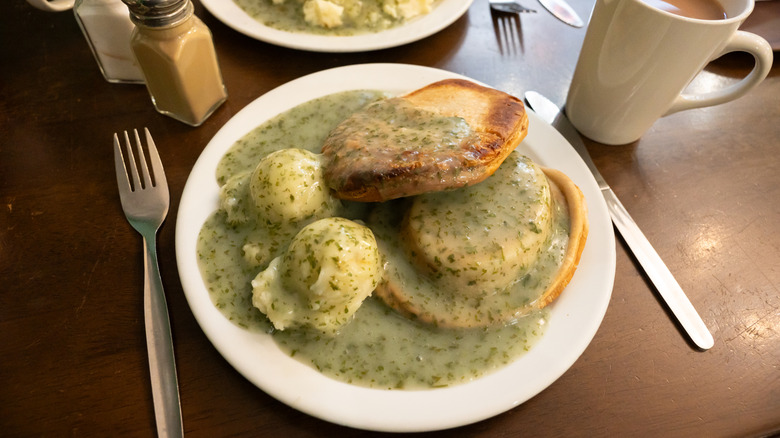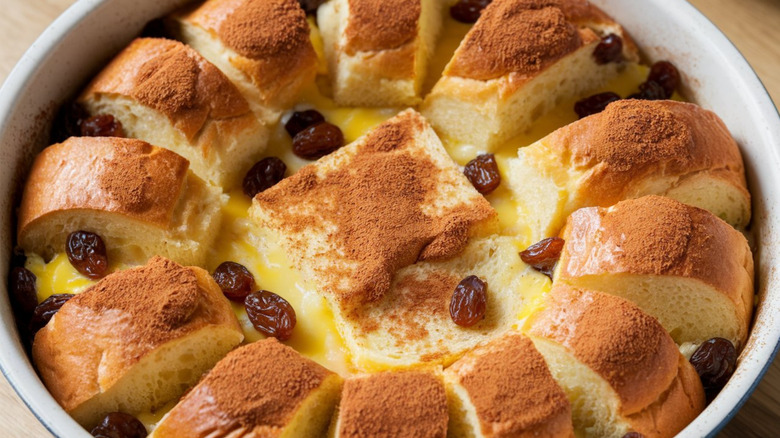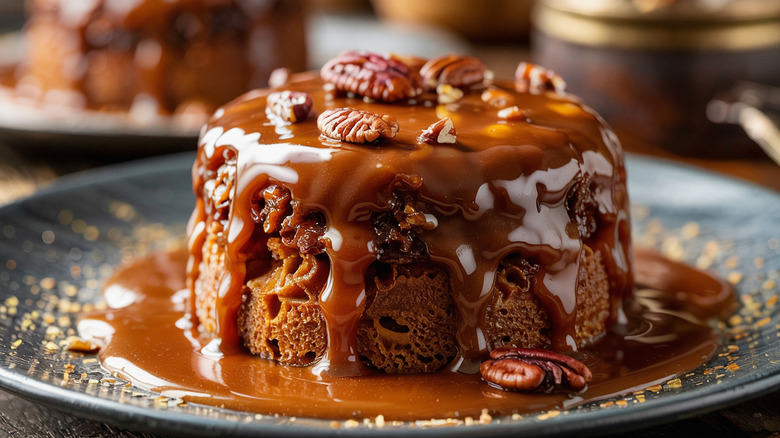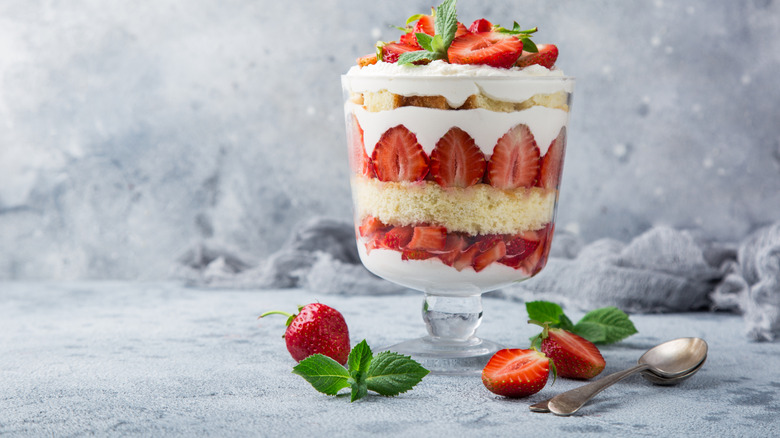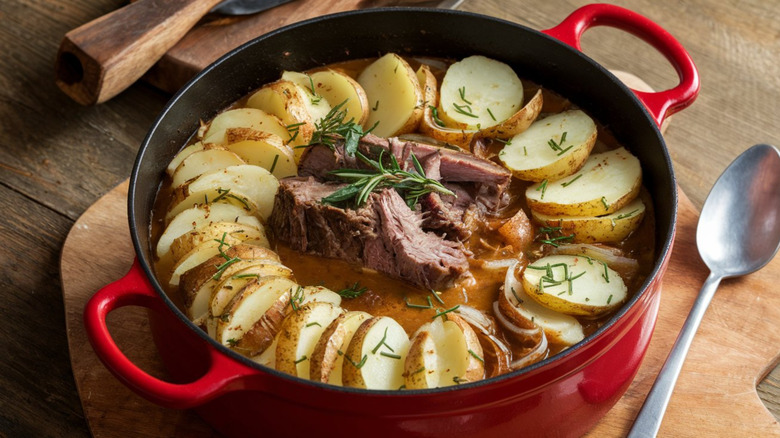15 English Dishes You Need To Try At Least Once
When you think of English food, one dish likely comes to mind first: Fish and chips. But actually, while this meal is undoubtedly beloved across the country, research suggests it's not English at all. In fact, it turns out, battered fish was first brought to the country in the 16th century by Spanish and Portuguese refugees. People across the UK adopted the dish as their own and have nurtured it ever since, turning it into an iconic British staple.
That said, there are plenty of authentic English dishes, actually invented in the country (as far as we can tell, anyway), that are worth your time and your tastebuds. There's the iconic Sunday roast, of course, as well as the full English breakfast, bangers and mash, toad in the hole, and many more. Keep reading to learn more about why you should give some of English's most loved dishes a try at least once.
Sunday roast
If you head out to a British pub on a Sunday, one thing is almost certain: There will be a selection of roast dinners on the menu. Think crispy roasted potatoes, piles of vegetables (usually broccoli, carrots, and parsnips), lashings of rich gravy, a generous portion of bread-based stuffing, Yorkshire pudding, and, then the main event: thick slices of beef, chicken, lamb, pork, or nut roast. Often, it's offered up carvery-style, which is basically just a large self-serve buffet of all the roast dinner staples. If you like comforting, cozy, hearty dishes that feel like a hug on a plate, the Sunday roast is for you.
Roast dinners don't have to be eaten in a pub. They're easily whipped up from home, too. In fact, families all over England and the rest of the U.K. often opt to cook them from home every Sunday, and it's been that way for decades. In the 19th century, amid the Industrial Revolution, Sunday was an important day of rest and recuperation. After working all week, people would go to church while meat and vegetables roasted in the oven, ready for their return.
But while roast dinners might have become widespread during the 1800s, their roots were actually planted much earlier. Records suggest that the English Tudor monarch King Henry VII always dined on roasted meat on Sundays, for example.
Yorkshire pudding
A Yorkshire pudding is technically part of the Sunday roast, but it's so iconic, it deserves its own spot on this list. The beloved savory treat is basically a baked bread pudding, made with a simple batter of eggs, flour, and milk (but it can also be made with vegan ingredients, too). Yorkshire puddings are puffy and light (kind of like a soufflé), a little crunchy and crispy, and perfect when doused with thick gravy. You'll often find them served with Sunday roasts, but lately, some restaurants have been getting creative with this English classic, using them as the base for dishes like burritos and hearty sandwiches.
As the name suggests, the Yorkshire pudding was likely invented in Yorkshire in England. At least, that's where the first recipe was recorded in an 18th century cookbook. But that said, the exact place of its origin is unknown. Since then, it has turned into a much-loved cornerstone of British cuisine. Wartime leader Winston Churchill was famously a big fan of the Yorkshire pudding, and reportedly used to enjoy them with a Sunday roast while he spoke about war tactics with political allies.
Full English breakfast
It's safe to say that if you love fried food, you'll probably love a full English breakfast. Often referred to as a fry-up, traditionally, this dish usually consists of multiple fried ingredients like bacon, sausages, eggs (sunny side up or scrambled, depending on preference), black pudding (a type of blood sausage), tomatoes, mushrooms, and potatoes (or hash browns). Often, it also features baked beans and toast on the side, too.
This iconic English dish has a long history. It first started to become popular in the 14th and 15th century, generally among the landed gentry, who were the richest in society and could afford such an elaborate breakfast. It became more popular throughout the Victorian era, again with the richer classes who liked to show off expensive English breakfast buffets to their peers.
Today, English breakfast isn't so elite, of course, and it has also evolved beyond the original recipe for many people. If you love the idea of a fry-up, but not the animal products, it's easy to make a plant-based version with scrambled tofu and vegan bacon and sausage, for example. If you love the sound of the ingredients, but not so much the fried food, then you can also cook most of the ingredients in this popular breakfast dish under the grill or in the air-fryer, depending on your preference.
Bangers and mash
If there's one thing that the English do well when it comes to food, it's comfort. The cuisine doesn't have the flavor of, say, Indian or Chinese food, but it is hearty and warming, which is important for a country that isn't known for its great weather. Aside from a Sunday roast, one of the most comforting dishes that England has to offer has to be bangers and mash.
Bangers and mash is incredibly simple. It's basically just sausages (pork or plant-based, depending on your dietary preference) served with fluffy mashed potato and lots and lots of gravy (usually onion-based). Often, it's served with peas on the side, too.
The comfort classic has been eaten in England for decades. In fact, the dish got its name during World War I. No, it wasn't to do with the bang of the bombs, it was actually because sausages were filled with so much water (due to meat shortages) that they used to actually explode when they were cooked.
Toad in the hole
If you like the sound of bangers and you like the sound of Yorkshire puddings, then you'll love the sound of this next traditional English dish. A classic toad in the hole doesn't actually involve any toads (so you can breathe a sigh of relief). No, the reality is much more appetizing: Sausages cooked in batter and smothered with, you guessed it, lots of gravy. Usually, it's served with classic English vegetables on the side, like potatoes, peas, and carrots.
Toad in the hole is another dish that was likely born during the years of the Industrial Revolution. Meat was expensive for most working people, and cooking it in batter meant that dishes weren't further and fed more people. Initially, pretty much any meat was cooked in toad in the hole, but after a recipe for the dish with bangers was published in the cookbook "Mrs. Beeton's Book of Household Management" in 1861, sausages became the go-to for most people.
And as for the name? That's easy. One widely accepted definition claims it's simply because the sausages in the batter look like toads peeking out of a hole.
Bubble and squeak
Another thing you can count on the English for? Foods with odd names. We've had toad in the hole and bangers and mash, and now we give you: Bubble and squeak. Again, this is a pretty simple dish, made with just potatoes and vegetables fried together in a pan, but it's a comforting classic, perfect for fall and winter days when it's chilly outside.
Bubble and squeak was invented around the 18th century. Since then, it's typically been eaten on a Monday, as it helps to use up any leftovers from Sunday's feast. It used to be made with meat, but nowadays it's usually cooked as a vegetarian dish (that's likely a hangover from World War II, when expensive meat became less of a staple).
The dish is called bubble and squeak simply because of the noises that it makes while it's cooking. Cabbage, for example, which is one of the most common vegetables used in bubble and squeak, tends to bubble when cooked due to its high water content.
Spotted dick
If there was an award for the English dish with the oddest name, we would hazard a guess that it would probably go to spotted dick. The pudding dish sounds strange (and even rude) to us today, but back when it was invented in the Victorian Era, it actually made perfect sense. In old English, pudding was sometimes called puddick, which explains where the "dick" part comes from, and the "spotted" part? That's likely due to the currants in the dish, which make it look spotted.
Now we've cleared that up, what actually is a traditional spotted dick? It's basically a steamed sponge pudding made with suet, a type of hardened animal fat. It's flavored with lemon for a little tang, and the currants bring a hint of sweetness to the dish, too. Like all good English desserts, this pudding is hearty and filling, and best served with lots of creamy vanilla custard. If you don't like the sound of making a dessert with animal suet, you can also whip up this traditional English dessert with plant-based ingredients like vegetable suet or coconut oil.
Scotch egg
Given the name, you could be forgiven for thinking that Scotch eggs come from Scotland. But actually, this dish, which consists of a hard-boiled egg covered in meat and fried in breadcrumbs, was likely first invented in England. At least, that's what Fortnum & Mason claims. The iconic London department store states that it was the first to start serving Scotch eggs in the 1700s, when it served them up to weary travelers in the region.
However, it also acknowledges that the English favorite may have been inspired by the Indian dish nargisi kofta, which also features a hard-boiled egg encased in meat and fried. Fortnum & Mason's version was reportedly called a scotched egg because of the anchovies in the meat mix.
Regardless of where they really came from, the truth remains that scotch eggs are still a widely loved snack across England and the rest of the U.K.. They have continuously evolved from the original recipe, and now it's easy to find vegan and vegetarian renditions alongside traditional meaty versions, too.
Eton mess
The clue is in the name, but Eton mess was likely invented at Eton College. That's the prestigious all-boys boarding school in Berkshire that has educated everyone from Prince William to George Orwell.
There are a few fun stories around the creation of Eton mess. Some say that the dessert, which consists of meringue, strawberries, and cream, was dropped during a late 1800s Eton cricket match and then scooped up off the grass and eaten anyway. Another story notes that at a different cricket match, this time in the early 20th century, a labrador created the dessert by accidentally sitting on a strawberry pavlova. The truth is probably a lot more boring; it was likely simply served up by one of the school's cooks at some point in history.
Anyway, most people don't eat Eton mess for its backstory, they eat it because it tastes sweet and delicious. The dessert is a nice mix of double cream, crushed meringue, juicy strawberries, making it perfect for the warmer summer months.
Jellied eels
This one doesn't sound the most appetizing, but stay with us. People in London's East End have eaten jellied eels since the 1700s for a few reasons. Firstly, they used to be pretty easy to access, as the River Thames was once full of eels. They were also affordable, a good source of protein, and they didn't taste bad when they were boiled with ingredients like vinegar, salt, and chopped onion. The dish is called jellied eels because the fish has a natural gelatinous texture, which is released through cooking.
You can still buy jellied eels, which have been described as pleasantly salty and not at all fishy, in the East End of London. Fish and chip shop chain Poppie's, which has four locations across the city, also offers the East End classic on its menu. Don't want to eat eels? That's understandable, too. You can also make this traditional London dish using plant-based ingredients like cornstarch, shiitake mushrooms, and sweetened soy sauce.
Pie and mash
We're still in the East End for this one. Alongside jellied eels, another classic English dish from this part of London is pie and mash. It's as simple as it sounds, but it's incredibly nourishing and comforting. Traditionally, the pie is filled with baked beef and covered in liquor (a type of parsley sauce), before being served with a generous scoop of mashed potato.
Pie and mash shops are a key part of London's cultural heritage. They were first opened in the mid-1800s to serve the working classes, who, before that, had been used to eating street food or meals cooked at home. In fact, pie and mash shops were the first restaurant-style establishments that many poor Londoners had the chance to visit.
As well as pie and mash, these traditional shops usually served jellied eels and mincemeat pies. Today, many establishments have expanded their menus, offering everything from fruit pies to vegan options.
Bread and butter pudding
If you've eaten bread pudding and enjoyed it, you'll likely also love bread and butter pudding, because they're basically the same thing. Bread pudding actually originated from bread and butter pudding, which is usually made with ingredients like white bread, sultanas, cream, eggs, and butter, and served with custard.
The English are not alone with this one. In fact, there are many different versions of the same dessert, like the French pain perdu and the German ofenschlupfer, that have originated all over the world (likely because the desire to use up leftover bread is not unique to any single country).
Traditional English bread and butter pudding still stands up as a hearty enjoyable dessert today, but it was likely invented centuries ago. In fact, some records suggest it was eaten in the 13th century (when it was made with stale bread and referred to as poor man's pudding).
Sticky toffee pudding
Alongside Eton mess, sticky toffee pudding is one of the most beloved desserts in England and across the U.K. You can probably guess from the name, but this pudding is an indulgent mix of rich and sweet toffee sauce and a sweet, sticky sponge cake made with dates. Usually it's served with either ice cream, custard, or double cream. If you've got a sweet tooth, this is the pudding for you.
Despite its popularity, sticky toffee pudding hasn't actually been around that long (at least in comparison to some of the other dishes on this list). It was likely invented in the mid 20th century by a hotel in England's Lake District. The story goes that their guests loved it so much, word spread across the country, and sticky toffee pudding turned into a classic English sweet treat. That said, there are a few different origin stories for sticky toffee pudding. Some say it was inspired by Canadian pilots and their use of maple syrup in the U.K. during World War II, for example.
Trifle
If you're a fan of the sitcom "Friends," you're probably familiar with the trifle scene. One Thanksgiving, Jennifer Aniston's character, Rachel Green, tries to make a traditional English trifle, only to fail and add beef, peas, and onions, when the pages of the cookbook get stuck together and she confuses two recipes as one. That iconic scene has actually inspired many copycat recipes (only most swap out the beef, peas, and onions for chocolate alternatives), but, of course, a traditional trifle is nothing like Green's attempt.
Trifles are usually an indulgent mix of sponge cake (often soaked in sherry or brandy), custard, fruits, and whipped cream, usually layered on top of each other in a clear glass bowl. They're often served as dessert on special occasions, like birthdays, Jubilees, or Christmas, for example. They've been eaten across England for some time. In fact, some recipes date all the way back to the 16th century.
Lancashire hotpot
Finally, we have the Lancashire hotpot. This is a classic winter English dish, originating from, you guessed it, Lancashire. It is a hearty, warming stew, usually made with mutton, root vegetables, and potatoes.
Similar to the Sunday roast, this hotpot was first invented by Lancashire laborers during the Industrial Revolution. In fact, the dish has close ties to the city's cotton industry, which at its peak, produced around half of the world's cotton and employed around 440,000 people. Workers from the cotton mills needed convenient, nourishing food, so they would make a hotpot in the morning, and then leave it slow-cooking on the stove while they went out to work.
Today, Lancashire hotpots are often eaten out of choice rather than necessity. They're usually made with lamb instead of mutton, but they can also be made with a range of other ingredients, too, including vegetarian options like beans, lentils, and mushrooms.

